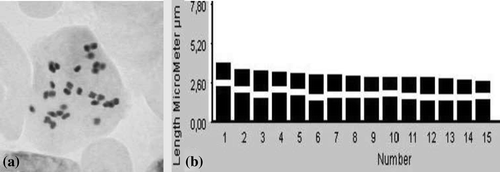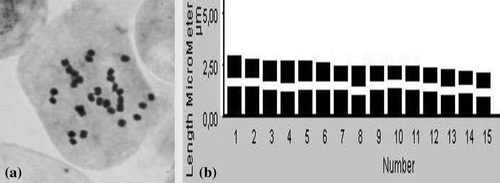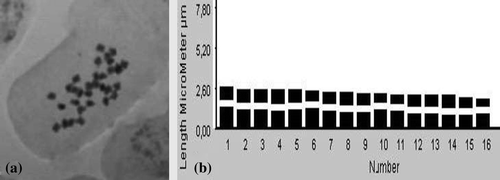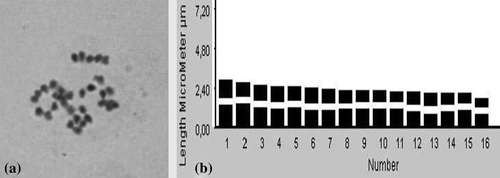Abstract
In this study, karyotypes of Teucrium sandrasicum O. Schwarz, T. brevifolium Schreb., T. divaricatum Sieber subsp. villosum (Celak.) Rech.f., T. flavum L. subsp. hellenicum Rech.f. and T. kotschyanum Poech taxa growing naturally in Turkey were determined. T. sandrasicum is endemic to Turkey. The squash method for preparation was used for chromosomal investigations. As a result, T. divaricatum subsp. villosum has a somatic chromosome number as 2n = 64 while T. flavum subsp. hellenicum and T. kotschyanum have 2n = 32 chromosomes and also T. sandrasicum and T. brevifolium have 2n = 30 chromosomes. The ideograms and detailed chromosome morphology measurements of the species were performed by the use of Image Analysis System (Bs200Pro). The research has made contribution to the taxonomic revision of the genus Teucrium in Turkey.
Introduction
Lamiaceae (the mint family) has a cosmopolitan distribution consisting of about 7200 species organized into 236 genera (Harley et al. Citation2004; Heywood et al. Citation2007; Yuan et al. Citation2010). The best part of the species of the Lamiaceae family has economic value due to the essential oil production. It is the third largest family in Turkey with 46 genera and about 580 species, almost 260 of which are endemic and the endemism rate is about 44% (Davis Citation1965-1985; Davis et al. Citation1988; Güner et al. Citation2000; Dirmenci Citation2012).
The genus Teucrium L. belonging to the Lamiaceae family is a large genus in the subfamily Ajugoideae (Harley et al. Citation2004). The polymorphic and cosmopolitan genus Teucrium comprises approximately more than 290 species (380 taxa) (Tutin and Wood Citation1972; Govaerts et al. Citation2010). Teucrium is also widely distributed in Europe, Asia, America, Australia and on the other hand the major area of distribution for this genus is the Mediterrenean area, containing about 96% of all taxa (Cantino Citation1992; Navarro and El Oualidi Citation2000). This genus can be distinguished from the other Lamiaceae genera with some features.
In the Flora of Turkey (Ekim Citation1982), the genus Teucrium is represented by 27 species and the total number has reached 34 species (46 taxa) by adding the new species and new records and sixteen of these taxa are endemic for Turkey (Ekim Citation1982; Duman Citation2000; Dönmez Citation2006; Dönmez et al. Citation2010; Dinç and Doğu Citation2012; Dirmenci Citation2012).
There are some studies about the chromosome numbers (Table ) and karyotypes of the Teucrium genus, in the literature. Chromosome numbers vary greatly and the reported chromosome numbers are 2n=10, 14, 16, 18, 22, 26, 28, 30, 32, 36, 39, 48, 52, 56, 58, 60, 62, 64, 78, 80, 86, 90, 96 and 104 in the genus Teucrium (http://www.tropicos.org/Project/IPCN).
The aim of this study is to provide a detailed karyology of the five Teucrium taxa distributing in Turkey. Chromosome counts have been reported for many species in Teucrium. Although some researchers studied the karyotypes of its species, only a few karyotypes had been made on this genus. The lack of karyological studies about Teucrium are probably a result of the difficulties to study with the small length of chromosomes. Besides, in this study somatic chromosome numbers and karyotype analysis of studied taxa were determined.
Materials and methods
Plant materials
Mature seeds and plant sample were collected during the field trip from the different localities in Turkey (Figure ). The localities, collectors and voucher numbers are shown in Table . All samples germinated in wet filter papers in petri dishes which were pretreated in distilled water at 20±1°C for several days in Necmettin Erbakan University, Faculty of Science.
Figure 1. Habits of the taxa. (A), T. sandrasicum; (B), T. brevifolium; (C), T. flavum subsp. hellenicum; (D), T. divaricatum subsp. villosum; (E), T. kotschyanum.
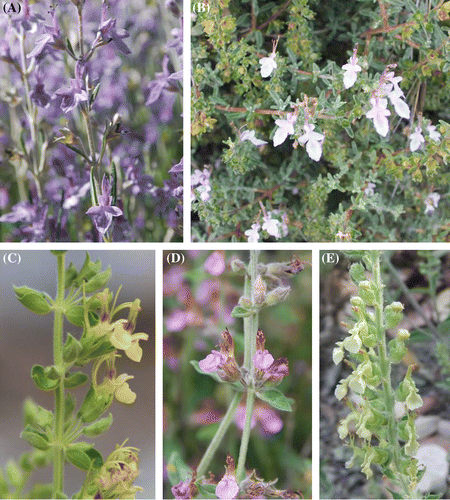
Table 1. Localities of taxa used in the research.
Chromosome analysis
Karyomorphological observations were made on mitotic metaphase cells of root-tips obtained from germinated seeds. Root tips were pretreated for 16h in α-monobromonaphthalene at 4°C and washed with distilled water and finally fixed in Carnoy’s solution (absolute ethanol and glacial acetic acid 3:1), overnight. The root tips were hydrolysed for 10 min in 1 N HCl at room temperature, washed and stained in 2% (w/v) aceto-orcein for 2 h. Stained root tips were then squashed in a drop of 45% acetic acid and permanent slides were made by mounting in Depex. The photographs, enlarged 10x100, were taken using a camera attached to the microscope. Only the slides with a good spread, clearly observable morphologies, and somatic root tips on the same plane were used. Chromosome measurements were made in at least ten well-spread metaphases, bearing the same chromosome contraction. The karyotype characterizations such as absolute chromosome length, total haploid chromosome length, centromeric index and arm ratio were measured and ideogram was designed by using an Image Analysis System (Duran et al. Citation2010; Martin et al. Citation2008; 2009). The ideogram was drawn based on centromeric index and arranged in the decreasing size order. Chromosomes were classified using the nomenclature of Levan et al. (Citation1964). The classification of chromosomes as median (m), submedian (sm), subterminal (st) and terminal point (T) were based on the analysis of metaphase chromosomes.
Results and discussion
In this study, the somatic chromosome numbers and the karyotypes of the five taxa belonging to the genus Teucrium were determined. The ideograms were drawn based on centromeric index and arranged in the decreasing size order. The smallest chromosome length was measured as 1.21 μm in T. divaricatum subsp. villosum while the biggest of that was 3.51 μm in T. sandrasicum. The smallest total haploid chromosome length was measured as 29.52 μm from the species of T. kotschyanum. T. divaricatum subsp. villosum has the biggest total haploid chromosome length which is 63.71 μm. T. brevifolium, T. kotschyanum and T. flavum subsp. hellenicum have the smallest arm ratio (1.00), and T. divaricatum subsp. villosum has the biggest (2.40). The smallest centromeric index (0.71) was measured in T. divaricatum subsp. villosum while the biggest of that (3.77) was observed in T. flavum subsp. hellenicum. In terms of relative length, T. divaricatum subsp. villosum has the lowest value (1.90) while T. sandrasicum has the highest (8.67).
Teucrium sandrasicum
The chromosome number of T. sandrasicum was determined as 2n = 30 (Figure a). The shortest chromosome length is 2.24 μm, the longest chromosome length is 3.51 μm, and haploid chromosome length is 40.54 μm. Chromosome arm ratios were measured as 1.05–2 μm. Centromeric index varies between 1.97 μm and 3.48 μm, and relative lengths vary from 5.51 μm to 8.67 μm. The chromosome sets consist of eleven median chromosomes and four submedian chromosomes. The ideogram was given in Figure b.
Teucrium brevifolium
The chromosome number of T. brevifolium was determined as 2n = 30 (Figure a). The shortest and the longest chromosome lengths are 1.61 μm and 2.46 μm, respectively. And the haploid chromosome length is 30.83 μm. Chromosome arm ratios were measured as 1–1.92 μm. Centromeric indices vary between 2.09 μm and 3.50 μm, and the relative lengths vary from 5.24 μm to 7.96 μm.The chromosome sets consist of thirteen median chromosomes and two submedian chromosomes. The ideogram was given in Figure b.
Teucrium kotschyanum
The chromosome number of T. kotschyanum was determined as 2n = 32 (Figure a). The shortest chromosome length is 1.49 μm. The longest chromosome length is 1.90 μm, and haploid chromosome length is 29.52 μm. Chromosome arm ratios are measured as 1–1.92 μm. Centromeric index varies between 1.84 μm and 3.13 μm, and relative lengths vary from 5.06 μm to 7.51 μm. The chromosome sets consist of twelve median chromosomes and four submedian chromosomes. The ideogram was given in Figure b.
Teucrium flavum subsp. hellenicum
The chromosome number of T. flavum subsp. hellenicum is 2n = 32 (Figure a). The shortest chromosome length is 1.36 μm and the longest chromosome length is 2.51 μm. In addition, the haploid chromosome length is 30.69 μm. The chromosome arm ratios were measured as 1–1.80 μm. The centromeric index varies between 1.93 μm and 3.77 μm, and relative lengths vary from 4.43 μm to 8.18 μm. The chromosome sets consist of fifteen median chromosomes and one submedian chromosome. The ideogram was given in Figure b.
Teucrium divaricatum subsp. villosum
The chromosome number of T. divaricatum subsp. villosum was determined as 2n = 64 (Figure a). 1.21 μm is the shortest and 3.38 μm is the longest chromosome lengths. The haploid chromosome length is 63.71 μm. Chromosome arm ratios are measured as 1.07–2.40 μm. Centromeric index varies between 0.71 μm and 2.17 μm, and relative lengths vary from 1.90 μm to 5.30 μm. The chromosome sets consist of twenty-seven median chromosomes and five submedian chromosomes. Figure b illustrated the ideogram.
The previous studies about chromosome numbers of Teucrium genus is shown at Table . As seen from the table, there are many studies about the chromosome numbers of the Teucrium. Also there are some karyotype analysis in the literature.
Table 2. Previous chromosomal study for Teucrium.
In this karyological study, three somatic chromosome numbers (2n = 30, 2n = 32 and 2n = 64) were observed in the taxa belonging to Teucrium. As known from the previous studies, the members of the sect. Teucrium have 30 or 60 chromosomes (Navarro and El Oualidi Citation2000). T. sandrasicum and T. brevifolium belong to the sect. Teucrium and their chromosome numbers were obtained as 2n = 30 in this study. In addition, Strid (Citation1965) was reported the chromosome number of T. brevifolium as 2n = 30 but there was no karyotype analysis. Our results confirm the chromosome number of T. brevifolium and also karyotype formula and chromosomal ideogram of this taxon are given for the first time, in this study. The karyotype formula was obtained as 13m + 2sm for T. brevifolium. However, there is no record for the Turkish endemic T. sandrasicum. The chromosome number, the karyotype formula and the ideogram of T. sandrasicum were reported for the first time with this study. As mentioned above, the chrosome number of this taxon is 2n = 30 and the karyotype formula is 11m + 4sm. T. marum, T. campanulatum, T. pseudo-chamaepitys belong to the sect. Teucrium and their chromosome numbers are also 2n = 30 (Table ).
T. flavum subsp. hellenicum and T. divaricatum subsp. villosum are classified in the same section and their section is Chamaedrys (Mill.) Schreb. Some members of this section show polyploidy. The known chromosome numbers of this section are 2n = 28, 30, 32, 58, 60, 62, 64, 96 (Navarro and El Oualidi Citation2000; Strid Citation1965; Valdes-Bermejo and Crespo Citation1978; Love and Love Citation1982; Afzal-Rafii et al. Citation1986; Baltisberger Citation2006). T. divaricatum subsp. villosum has 2n = 64 and the karyotype formula is 27m + 5sm. In sect. Chamaedrys, T. divaricatum and T. chamaedrys have polyploidic structures but T. flavum L. have 2n = 32 in the literature (Table ). Besides, we found the same results and the data provide consistency with the literatures. In addition to chromosome number, we obtained the karyotype formula and the ideogram. The karyotype formula of T. flavum subsp. hellenicum is 15m + 1 sm.
T. kotschyanum is a member of sect. Scorodonia (Hill) Schreb. Navarro and El Oualidi reported the chromosome numbers of this section as 2n = 31, 32. In addition, the chromosome number of this taxon is shown as 2n = 32 in Table . In this study, karyotype formula was also obtained for the first time and the karyotype formula of this taxon is 12m + 4sm.
Considering the literature, the chromosome numbers of Teucrium divaricatum Sieber subsp. divaricatum were counted but the karyotype analysis of this taxa was not examined (Montmollin Citation1986). However, the chromosome morphologies of this taxon are presented for the first time. And also, T. sandrasicum were studied for the first time.
In the present researches, the somatic chromosome numbers of five Teucrium taxa from the Lamiaceae family were defined. We believe that this study will play a positive role to enlighten this taxonomically revision of the genus.
Acknowledgments
We thank the Research Fund of Balıkesir University for the financial support of our research [Project No.: BAU-BAP 2012/18].
References
- Aboucaya A, Verlaque R. 1990. IOPB chromosome data 2. Int. Organ. Pl. Biosyst. Newslett. (Zurich). 15(1):10–11.
- Afzal-Rafii Z, Bosc MP, Viano J. 1986. Investigations cytogénétiques de quelques plantes médicinales des massifs du Lubéron, de Lure et du Mont-Ventoux. Rev. Cytol. Biol. Vég. Bot. 9(3–4):251–262.
- Afzal-Rafii Z, Vianot J, Ramade M, Bourreil MP. 1985. Analyses des caracteres caryologiques et ecologiques de quelques taxons dans les massifs du Luberon, de Lure et du Mont-Ventoux [Analyses of caryological and ecological characters of some taxa in the mountains of Luberon, Lure and Mont-Ventoux]. Rev. Cytol. Biol. Veg. Bot. 8(2):33–62.
- Alcaraz F, Sánchez-Gómez P, Carrión JS. 1988. Teucrium x estevei Alcaraz. Sánchez-Gómez & Carrión hybr. nov. Lazaroa. 9(1):25–30.
- Baltisberger M. 2006. Cytological investigations on Bulgarian phanerogams.Willdenowia. 36 (Special Issue):205–216.
- Cantino PD, Harley RM, Wagstaff SJ. 1992. Genera of Labiatae: status and classification. In: Harley RM, Reynolds T. editors, Advances in Labiate Science. Royal Botanic Gardens. Kew. 511–522.
- Castroviejo S, Bayon E. 1990. Notas sobre Teucrium marum L. y sus afines en las Islas Baleares. Anales Jard. Bot. Madrid. 47(2):507–509.
- Dalgaard V. 1991. Chromosome studies in flowering plants from Macaronesia II. Willdenowia. 20:139–152.
- Davis PH. 1965–1985. Flora of Turkey and the East Aegean Islands. Vol. 1–9. Edinburgh Univ. Press. Edinburgh.
- Davis PH, Mill RR, and Tan K. 1988. Flora of Turkey and the East Aegean Islands (First Supplement). Vol. 10. Edinburgh Univ. Press. Edinburgh.
- Dempsey RE, Gornall RJ, Bailey JP. 1994. Contributions to a cytological catalogue of the British and Irish flora. 4. Watsonia. 20(1):63–66.
- Díaz Lifante Z. 1991. Números cromosomáticos para la flora Española. 630–642. Lagascalia. 16(2):328–333.
- Dinç M, Doğu S. 2012. Anatomical and micromorphological studies on Teucrium sect. Isotriodon (Lamiaceae) in Turkey with taxonomic note. Biologia. 67(4):663–672.
- Dirmenci T. 2012. Teucrium L. In: Güner A, Aslan S, Ekim T, Vural M, Babaç MT, editors. Türkiye Bitkileri Listesi (Damarlı Bitkiler). İstanbul: Nezahat Gökyiğit Botanik Bahçesi ve Flora Araştırmaları Derneği Yayını, pp. 595–598.
- Dobea C, Hahn B, Morawetz W. 1997. Chromosomenzahlen zur Gefässpflanzen-Flora Österreichs. Linzer Biol. Beitr. 29(1):5–43.
- Dönmez AA. 2006. Teucrium chasmophyticum Rech. f. (Lamiaceae): a new record for the flora of Turkey. Turk. J. Bot. 30(4):317–320.
- Dönmez AA, Mutlu B, Özçelik AD. 2010. Teucrium melissoides Boiss. & Hausskn.ex Boiss. (Lamiaceae): a New Record for Flora of Turkey. Hacettepe J. Biol. & Chem. 38(4):291–294.
- Duman H. 2000. Teucrium L., pp. 197–198. In: Güner A, Özhatay N, Ekim T, and Başer KHC. (eds). Flora of Turkey and the East Aegean Islands. vol. 11 (Supplements). Edinburgh Univ. Press. Edinburgh.
- Duran A, Martin E, Öztürk M, Çetin Ö, Dinç M, Özdemir A. 2010. Morphological, karyological and ecological features of halophytic endemic Sphaerophysa kotschyana (Leguminosae) in Turkey. BioDiCon. 3(2):163–169.
- Ekim T. 1982. Teucrium L., pp. 53–75. In: Davis P.H. (ed.). Flora of Turkey and the East Aegean Islands. vol. 7. Edinburgh Univ. Press. Edinburgh. Royal Botanic Gardens. Kew.
- Fernandes A, Leitão MT. 1984. Contribution à l’étude cytotaxinomique des Spermatophyta du Portugal XVIII—Lamiaceae.Mem. Soc. Brot. 27:27–75.
- Fernandez Casas J, Aguilera JG, Rejon MR. 1978. Notas sobre cariologia de Lamiaceas. Anales Inst. Bot. Cavanilles. 34(2):723–732.
- Gammar Ghrabi Z, Mabli M, Puech S. 1989. Contribution a l’étude biologique et caryosystématique des Teucrium (Labitatae) de Tunisie. Nat. Monspel. 54:79–92.
- Ghaffari SM. 2006. New or rare chromosome counts of some angiosperm species from Iran. Iran. J. Bot. 11(2):185–192.
- Gill LS. 1984. The incidence of polyploidy in the West-Himalayan Labiatae. Rev. Cytol. Biol. Vég. Bot. 7(1):5–16.
- Govaerts R, Paton A, Harvey Y, Navarro T, Del Rosario GPM. 2010. World checklist of lamiaceae. The Board of Trustees of the Royal Botanic Gardens, Kew. www.kew.org/wcsp/ [accessed 12 April 2014].
- Güner A, Özhatay N, Ekim T, Başer KHC. 2000. Flora of Turkey and the East Aegean Islands (Second Supplement). vol 11. Edinburgh Univ. Press, Edinburgh.
- Harley RM, Atkins S, Budantsev AL, Cantino PD, Conn BJ, Grayer R, Harley MM, De Kok R, Krestovskaja T, Morales R, Paton AJ, Ryding O, and Upson T. 2004. Labiatae, pp. 167–275. In: Kadereit J.W. (ed.). The families and genera of vascular plants. vol. 7. Springer Verlag. New York, NY.
- Heywood VH, Brummitt RK, Culham A, Seberg O. 2007. Lamiaceae: 179–181. In: Flowering Plant Families of the World. New York, NY, Firefly Books.
- Hollingsworth PM, Gornall RJ, Bailey JP. 1992. Contribution to a cytological catalogue of the British and Irish flora. 2. Watsonia. 19:134–137.
- Levan A, Fredga K, Sandberg AA. 1964. Nomenclature for centromeric position on chromosomes. Hereditas. 52(2):201–220.
- Love A, Love D. 1982. In: IOPB chromosome number reports LXXVI. Taxon. 31:583–587.
- Martin E, Duman H, Ünal F. 2008. Karyological studies of five taxa of Sideritis L. (Lamiaceae) section Hesiodia Benth. from Turkey. Caryologia. 61(2):115–122.
- Martin E, Duman H, Ünal F. 2009. Karyological studies on section Empedoclia of Sideritis (Lamiaceae) from Turkey. Caryologia. 62(3):180–197.
- Mártonfi P. 1995. Teucrium montanum (Lamiaceae) in the Czech and Slovak Republics. Preslia. 66(4):289–304.
- Montmollin BD. 1986. Étude cytotaxonomique de la flore de la Crète. III. Nombres chromosomiques. Candollea. 41(2):431–439.
- Navarro T, El Oualidi J. 2000. Trichome morphology in Teucrium L. (Labiatae) A taxonomic review. Anales Jardin Botanico De Madrid. 57(2):277–297.
- Pogan E, Czapik R, Jankun A, Kuta E. 1982. Further studies in chromosome numbers of Polish angiosperms. Part XV. Acta Biol. Cracov. Ser. Bot. 24:113–126.
- Ruíz de Clavijo E. 1990. Números cromosomáticos de plantas occidentales, 608–618. Anales Jard. Bot. Madrid. 47(2):425–430.
- Saggoo MI. 1983. Cytomorphological studies on plants of economic importance of Bicarpellatae from India. 259 pp.
- Strid A. 1965. Studies in the Aegean flora VI. Notes on some genera of Labiatae. Bot. Not. 118(1):104–122.
- Strid A, Andersson IA. 1985. Chromosome numbers of Greek mountain plants. An annotated list of 115 species. Bot. Jahrb. Syst. 107:203–228.
- Tutin G, Wood D. 1972. Teucrium L., In: Tutin T.G. Heywood V.H. Burges N.A. Moore D.M. Valentine. pp. 129–135.
- Özcan T. 2013. Presence of Teucrium microphyllum in Turkey: Morpho-anatomical, karyological and ecological studies. BioDiCon. 6(3):79–87.
- Valdes-Bermejo E, Crespo AS. 1978. Datos cariologicos y taxonomicos sobre el genero Teucrium L. (Labiatae). Acta Bot. Malac. 4:27–54.
- Van Loon JC, Kieft B. 1980. In Chromosome number reports LXVIII. Taxon. 29:538–542.
- Verlaque R, Contandriopoulos J, Aboucaya A. 1993. Recherches cyto-biogĕographiques sur quelques taxons rares ou endĕmiques de Corse: I. Candolle. 48(2):562–576.
- Vogt R, Aparicio A. 1999. Chromosome numbers of plants collected during Iter Mediterraneum IV in Cyprus. Bocconea. 11:117–169.
- Vogt R, Oberprieler C. 1994. Chromosome numbers of North African phanerogams. IV. Candollea. 49(2):549–570.
- Wentworth JE, Bailey JP, Gornall RJ. 1991. Contributions to a cytological catalogue of the British and Irish flora, 1. Watsonia. 18:415–417.
- Yildiz K, Gücel S. 2006. Chromosome numbers of 16 endemic plant taxa from northern Cyprus. Türk Bot. Derg. 30(3):181–192.
- Yuan YW, Mabberly DJ, Steane DA, Olmstead RG. 2010. Further disintegration and redefinition of Clerodendrum (Lamiaceae): implications for the understanding of the evolution of an intriguing breeding strategy. Taxon, 59(1):125–133. http://www.tropicos.org/Project/IPCN

